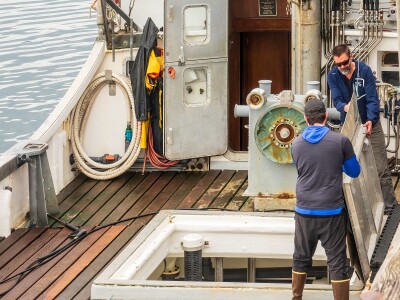Surviving reel danger
From U.S. Coast Guard reports
The six-man crew of a 150-foot trawler was pair-trawling approximately 45 miles off Sandy Hook, N.J., and preparing to bring a bag of mackerel alongside.
A 14-inch-diameter lay-flat rubber hose stored on a reel next to the rail was used to pump the mackerel out of the net. By 7:30 a.m. the reel engaged and the hose started spooling off the reel. A crewman was positioned between the reel and the rail, and was guiding the hose over the side. The crewman fed the hose out over his head, but a joint in the hose caught him across the shoulders, dragging him under and into the hose reel.
The crew stopped the reel and carefully extricated the crewman. They took him to the mess deck, placing him flat on his back. He told the skipper that he felt that some of his bones were broken; he was having trouble breathing and had chest and sternum pain.
Noting the crewman was cold, clammy and showing signs of shock, the skipper immediately contacted the Coast Guard, explained the situation, relayed the crewman's vital signs and requested help. A Coast Guard flight surgeon recommended a medevac.
A Coast Guard cutter about 7 miles away was diverted to the trawler, arriving around 9 a.m. The cutter's corpsman went aboard to evaluate the injured crewman, who was having back spasms and could barely move. The corpsman had the cutter send a backboard and neck brace and began preparing for evacuation.
The crewman was transported to a hospital. Several of his bones, including two vertebrae, were fractured. He was treated with surgery.
Lessons learned
Of the 26 deaths in the East Coast multispecies groundfish trawl fishery over the last decade, entanglement in deck winches caused four.
Know where the danger zones are around equipment. Stay clear of outrunning gear, and don't stand on gear. Never stand in the bight of a line. Avoid straddling or stepping over lines or wires under tension. Don't try guiding trawl wire or other types of running gear with your hands, feet or hips.
Learn the signals used aboard your vessel for communication between the deck, bridge and/or machinery operating stations and always wear your personal protective equipment.
Only manually carry a victim to remove them from immediate danger, such as fire or moving machinery. When possible perform essential first aid before moving the victim: Check for breathing and pulse; control heavy bleeding; treat for shock; and dress wounds and immobilize fractures. Then use a litter, stretcher or backboard to transport the seriously injured, especially if you suspect neck or back injuries.
The trawler, Coast Guard cutter and helicopter crews coordinated initial treatment and stabilized the injured crewman. Their response, under extremely stressful conditions, got him the medical treatment he needed. Remember that the dangers deck machinery pose are real, and fish safe.
This article is based on U.S. Coast Guard reporting and is intended to bring safety issues to the attention of our readers. It is not intended to judge or reach conclusions regarding the ability or capacity of any person, living or dead, or any boat or piece of equipment.






